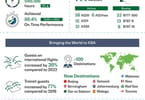As 66 swine flu infection cases have already been confirmed in the US, at the time of writing, bans on travel to Mexico on this health-related risk have been imposed. Cuba and Argentina have already suspended flights to Mexico, where swine flu is suspected of killing more than 150 people and contaminating well over 2,000.
More airlines and cruise lines such as Holland America, Royal Caribbean, Norwegian and Carnival, suspended stops over Mexico ports. Some cruise liners will still travel to Mexico, but will not let passengers disembark.
In the Middle East and smaller states like Dubai, though residents have not been exposed to the virus, several Gulf Cooperating Countries health department heads said they will hold an emergency meeting this weekend to discuss the threat of a swine flu pandemic to the region. Egypt has ordered the slaughter of 300,000 pigs, although the predominantly Muslim country doesn’t really rely on pork in their diet (only Christians in Egypt consume pork products). In the emirates, Humaid Mohammed Obeid Al Qutami, the UAE’s minister of health, will travel to Doha this Saturday to discuss measures against the deadly flu strain. “What we don’t want is to create a panic. Our key message is that the country is virus-free and that everything is ok,” he said.
Dr. Ali Bin Shakar, director general of the Ministry of Health said the UAE has established two agencies to coordinate preventive measures against the influenza strain. UAE authorities have, however, stopped short of issuing an alert to hospitals and clinics, or screening air and seaports for travelers with flu-like symptoms, Shakar said Tuesday.
In the US, warnings are getting more serious. Barbara Gault, director of research for the Institute for Women’s Policy Research said, “The Centers for Disease Control has recommended that those who are sick should stay home from work or school to avoid infecting others.
In this stressful economy, workers fear getting sick and having to call in. Worse, they just cannot sacrifice paychecks for the much-needed bed rest. Some cannot afford proper health care.
Gault said, “Analyses of Bureau of Labor Statistics and other data conducted by the Institute for Women’s Policy Research have found that less than half of workers have paid sick days, and only one in three are able to utilize sick days to care for sick children. Workers without paid sick days lose wages if they stay home, and many workers risk losing their jobs. As a result, workers who lack paid sick time are more likely to go to work with a communicable illness, and parents who cannot
stay home with a sick child are more likely to send sick children to school or day care. Workers who work in direct contact with the public, such as restaurant workers, child care workers, and hotel employees, are among the least likely to have paid sick days.”
David Katz, a family physician at CommuniCare Health Centers in Yolo County, California said, “We have had decreased capacity in our clinics in dealing with something like swine flu because we’ve had county and state cutbacks over the last year.”
Certainly, Gault fears that in the present economic situation, infected people nevertheless may go to work.
And those who do so and go to work or school while sick may infect co-workers,
customers, and classmates, resulting in even more infections. “With seasonal influenza, this pattern of infection is a serious problem, costing employers and families millions of dollars a year and sometimes causing serious illness or death, especially among infants and the identified as a serious cause for concern by the CDC and WHO) suggest that the swine flu has the potential to be much more costly and dangerous than typical seasonal influenza,” she added.
Mike Davis, author of The Monster at Our Door: The Global Threat of Avian Flu, said
“The Mexican swine flu, a genetic chimera probably conceived in the fecal mire of an industrial pigsty, suddenly threatens to give the whole world a fever. The initial outbreaks across North America reveal an infection already traveling at higher velocity than did the last official pandemic strain, the 1968 Hong Kong flu. …Given that domesticated seasonal Type-A influenzas kill as many as 1 million people each year, even a modest increment of virulence, especially if combined with high incidence, could produce carnage equivalent to a major war.”
In California, Katz says that CommuniCare is a network of community health centers that cares for the underserved population of the county.
“But I’m concerned about budgetary decisions being made in many counties in California that exclude undocumented county residents from the county-financed safety net health systems,” he said.
Added Davis: “Perhaps it is not surprising that Mexico lacks both capacity and
political will to monitor livestock diseases and their public health impacts, but the situation is hardly better north of the border, where surveillance is a failed patchwork of state jurisdictions and corporate livestock producers treat health regulations with the same contempt with which they deal with workers and animals.”
Similarly, a decade of urgent warnings by scientists in the field has failed to ensure the transfer of sophisticated viral assay technology to the countries in the direct path of likely pandemics. Mexico has world-famous disease experts, but it had to send swabs to a laboratory in Winnipeg (which has less than 3 percent of the population
of Mexico City) in order to ID the strain’s genome. Almost a week was lost as a consequence.
Davis said no one was less alert than the legendary disease controllers in Atlanta. According to the Washington Post, the CDC did not learn about the outbreak until six days after the Mexican government had begun to impose emergency measures. “Indeed, US public health officials are still largely in the dark about what’s happening in Mexico two weeks after the outbreak was recognized,” he said.
There should be no excuses. This is not a ‘black swan’ flapping its wings. Indeed, the central paradox of this swine flu panic is that while totally unexpected, it was accurately predicted, Davis explained.
Meanwhile, the world is watching the virus closely. Recession woes down, swine flu worries up!
Stocks go down. Everything goes down the tubes.
WHAT TO TAKE AWAY FROM THIS ARTICLE:
- “With seasonal influenza, this pattern of infection is a serious problem, costing employers and families millions of dollars a year and sometimes causing serious illness or death, especially among infants and the identified as a serious cause for concern by the CDC and WHO) suggest that the swine flu has the potential to be much more costly and dangerous than typical seasonal influenza,” she added.
- In the Middle East and smaller states like Dubai, though residents have not been exposed to the virus, several Gulf Cooperating Countries health department heads said they will hold an emergency meeting this weekend to discuss the threat of a swine flu pandemic to the region.
- Gault said, “Analyses of Bureau of Labor Statistics and other data conducted by the Institute for Women’s Policy Research have found that less than half of workers have paid sick days, and only one in three are able to utilize sick days to care for sick children.






















